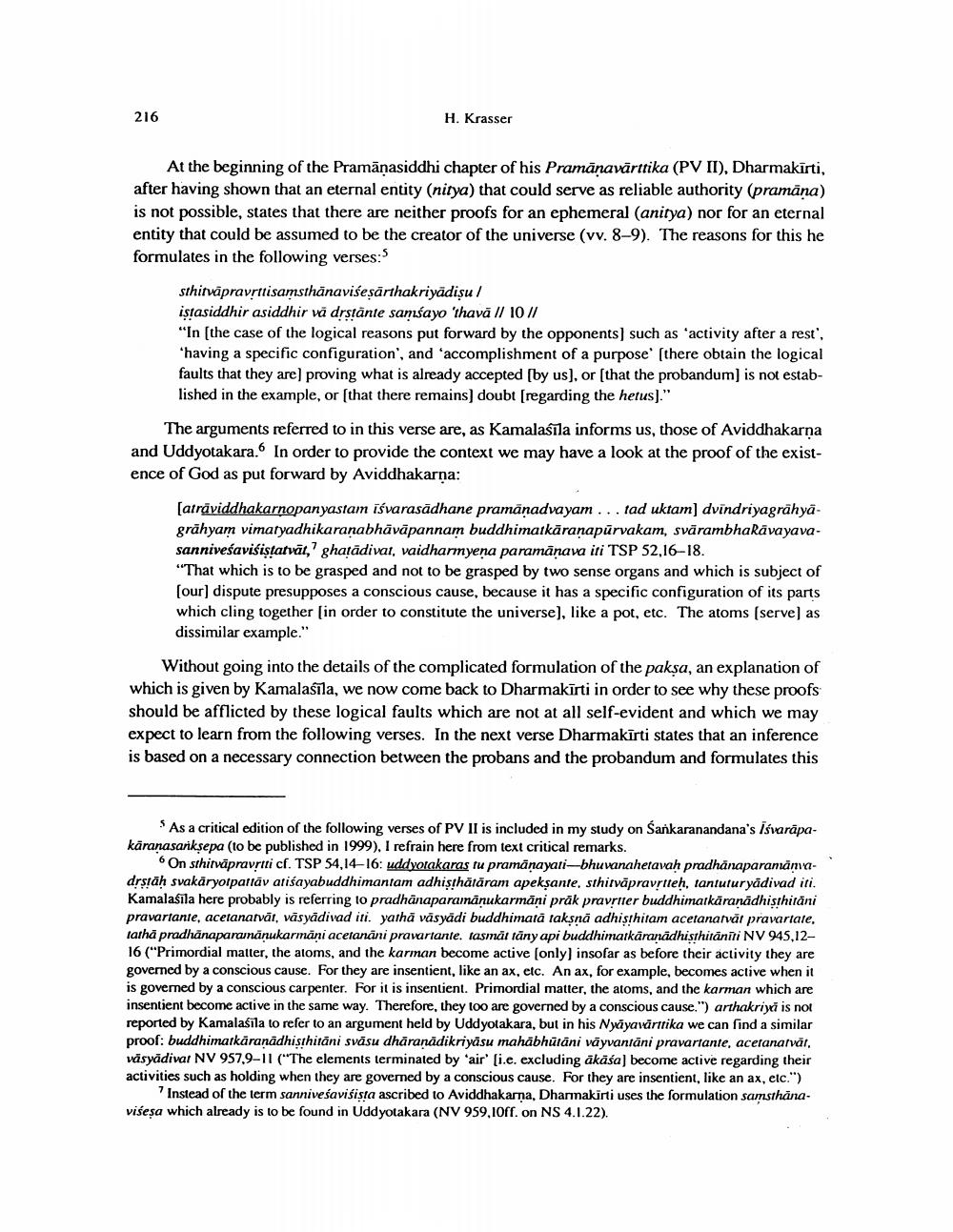________________
216
H. Krasser
At the beginning of the Pramānasiddhi chapter of his Pramānavārttika (PV II), Dharmakīrti, after having shown that an eternal entity (nitya) that could serve as reliable authority (pramāna) is not possible, states that there are neither proofs for an ephemeral (anitya) nor for an eternal entity that could be assumed to be the creator of the universe (vv. 8-9). The reasons for this he formulates in the following verses:S
sthitvāpravrttisamsthānaviseșärthakriyādişu / istasiddhir asiddhir vā drstante samsayo 'thavä // 10 // "In the case of the logical reasons put forward by the opponents, such as 'activity after a rest', 'having a specific configuration', and 'accomplishment of a purpose' (there obtain the logical faults that they are proving what is already accepted [by us), or that the probandum) is not established in the example, or (that there remains) doubt [regarding the hetus)."
The arguments referred to in this verse are, as Kamalasīla informs us, those of Aviddhakarna and Uddyotakara. In order to provide the context we may have a look at the proof of the existence of God as put forward by Aviddhakarna:
[atrāviddhakarnopanyastam išvarasādhane pramānadvayam... tad uktam) dvindriyagrāhyagrähyam vimatyadhikaranabhāvāpannam buddhimatkāranapūrvakam, svārambha Rāvayavasanniveśavisistatvät, ghatādivat, vaidharmyena paramänava iti TSP 52,16-18. "That which is to be grasped and not to be grasped by two sense organs and which is subject of (our) dispute presupposes a conscious cause, because it has a specific configuration of its parts which cling together (in order to constitute the universe), like a pot, etc. The atoms (serve) as dissimilar example."
Without going into the details of the complicated formulation of the pakşa, an explanation of which is given by Kamalasīla, we now come back to Dharmakīrti in order to see why these proofs should be afflicted by these logical faults which are not at all self-evident and which we may expect to learn from the following verses. In the next verse Dharmakīrti states that an inference is based on a necessary connection between the probans and the probandum and formulates this
As a critical edition of the following verses of PV II is included in my study on Sankaranandana's isvarāpakaranasariksepa (to be published in 1999), I refrain here from text critical remarks.
6 On sthitvāpravrtti cf. TSP 54,14–16: uddyotakaras tu pramanayati-bhuvanahetavah pradhanaparanamadrstah svakäryotpattāv atiśayabuddhimantam adhisthātāram apeksante, sthitvāpravrtteh, tantuturyādivad iti. Kamalasila here probably is referring to pradhanaparamānukarmāni prāk pravrtier buddhimaikäranädhisthitäni pravartante, acetanatvät, väsyädivad iti. yathā vāsyādi buddhimata taksna adhisthitam acetanatvāt pravartate, tathā pradhanaparamanukarmani acetanani pravartante. tasmāt tāny api buddhimatkäranädhisthitānīti NV 945,1216 ("Primordial matter, the atoms, and the karman become active (only) insofar as before their activity they are governed by a conscious cause. For they are insentient, like an ax, etc. An ax, for example, becomes active when it is governed by a conscious carpenter. For it is insentient. Primordial matter, the atoms, and the karman which are insentient become active in the same way. Therefore, they too are governed by a conscious cause.") arthakriya is not reported by Kamalaśila to refer to an argument held by Uddyotakara, but in his Nyayavartrika we can find a similar proof: buddhimatkäranadhisthitani svāsu dhāranădikriyasu mahābhūtäni väyvantāni pravartante, acetanatvāt, väsyādivat NV 957,9-11 ("The elements terminated by 'air' (i.e. excluding ākāśa) become active regarding their activities such as holding when they are governed by a conscious cause. For they are insentient, like an ax, etc.")
Instead of the term sanniveśavisista ascribed to Aviddhakarna, Dharmakirti uses the formulation samsthānavišesa which already is to be found in Uddyotakara (NV 959,10ff. on NS 4.1.22).




